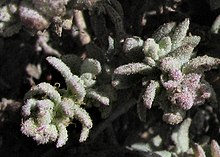Extriplex
| Extriplex | |
|---|---|
 |
|
| Extriplex californica | |
| Scientific classification | |
| Kingdom: | Plantae |
| (unranked): | Angiosperms |
| (unranked): | Eudicots |
| (unranked): | Core eudicots |
| Order: | Caryophyllales |
| Family: | Amaranthaceae |
| Subfamily: | Chenopodioideae |
| Tribe: | Atripliceae |
| Genus: |
Extriplex E. H. Zacharias |
| Species | |
| Synonyms | |
|
|
Extriplex is a plant genus in the subfamily Chenopodioideae of the Amaranthaceae family. It has been described in 2010 and comprises two species, that were formerly included in genus Atriplex. They are restricted to the California Floristic Province.
The species of Extriplex are annuals or perennial herbs up to 1 m high, growing erect or spreading to decumbent. Young plant parts are farinose, older ones glabrescent or scurfy. The sparsely or much branched stems are striate when young, later stramineous. The green to grayish leaves are alternate, the lowest sometimes nearly opposite, petiolated or not. Their leaf blades are 4–70 mm long and 2–40 mm wide, deltoid to ovate-rhombic (to subhastate) or lanceolate to elliptic, with irregularly sinuate-dentate or entire margins. The leaf anatomy is of the "normal" (non-Kranz) type of C3-plants.
The plants are monoecious. The inflorescences stand axillay or form dense or interrupted spikes or panicles of male and/or female flowers at the tips of the branches. Male flowers (with a bracteole) consist of 4 rounded-triangular perianth lobes, ca. 1 mm long, with cucullate tips, and 4 non-exserting stamens inserting on a disc. Female flowers are sitting within 2 opposite bracteoles, without perianth, consisting just of an ovary with 2 filiform, exserted stigmas.
In fruit, the bracteoles enclosing the fruit become accrescent, 3–4.5 × 2–3 mm, free or connate to the lower half. Their shape can be ovate, nearly round, or deltate with entire margins and acute to acuminate apices. Their surface is densely scurfy, smooth or ribbed. The subglobose or laterally compressed fruit (utricle) is not spongy, and does not fall at maturity. The membranous pericarp is free or slightly adheres to the seed. The vertically orientated seed has a black to dark-brown, smooth and shiny, hard seed coat. The annular embryo surrounds the copious farinaceous perisperm.
...
Wikipedia
